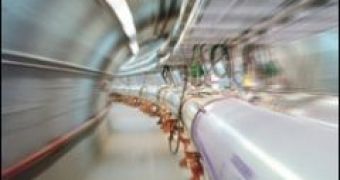Some may say that such actions are close to impossible, but researchers at the Relativistic Heavy Ion Collider, RHIC for short, have already achieved the performance of correcting the trajectory of particles traveling at 99,995 percent of the speed of light, by measuring fluctuations of particle beams as they speed through the 3.84-kilometer-long circumference of the particle accelerator. The work carried about at the RHIC facility has the role of understanding the conditions in the first fractions of seconds after the Big Bang.
The trajectory corrections are essential in order to keep the particle beam focused, as it is being accelerated through the collider, so that more collisions take place at one given time. Steven Vigdor, of the Brookhave Lab's Associate Laboratory Director for Nuclear and Particles Physics, manager of the RHIC program, says that by implying such methods physicists have the chance to create thousands of collisions per second, which mimic the conditions after the Big Bang event.
Preliminary results have already been able to show that only a few microseconds after the Big Bang, the universe was in a state similar to that of a perfect liquid, with no viscosity and strong interactions between individual particles. By recreating even more such collisions, physicists should be able to accurately measure the properties of the 'liquid,' so that they can test a series of predictions made by different physical theories, including the string theory of course.
The technique is named stochastic cooling, or statistic cooling, and is being implemented at particle colliders, where there is a need to create a more continuous stream of particles. The problem derives from the nature of quantum mechanics, which states that particle emissions will always take place randomly, on the basis of a statistical distribution. Thus, particles are not being emitted in continuous beams, but rather in bunches.
Accelerators, as the RHIC, work by colliding two beams of particles that move in opposite directions at relativistic speeds. Without taking into consideration the random emission of particles, the problem doubles in magnitude while using two separate beams of particles, greatly reducing the number of collisions. Usually, high-energy experiments use as particles gold nuclei, composed of protons and neutrons of course, that when colliding they determine the appearance of an extremely hot state of matter, somehow identical to that found in the first moments after the Big Bang.
However, as they are being circulated through the accelerator at relativistic speeds, the ions take a divergent path and start spreading out with the distance they cover. By measuring the random fluctuation in the particle beams during the emission phase and, at certain points, over the accelerator's length, physicists can exactly calculate the signal required to make trajectory correction, so that particles maintain their path.
The signal is sent through fiberoptic, or microwave system, to an electric field generator just in front of the beam, thus the corrections can be made as the beam crosses the respective electric field, to compact and cool the ion beam. This can be done through two different methods, either sending the signal all the way around the accelerator or by meeting the beam halfway, as it circles the accelerator for the second time.
For now, RHIC physicists have only been able to test the statistical cooling method on a longitudinal direction, and they have already reported a 20 percent increase in the collision rate, but with additional funding they should have the resources to further improve the collision rates, by combining longitudinal with transversal cooling to over 500 percent.

 14 DAY TRIAL //
14 DAY TRIAL //